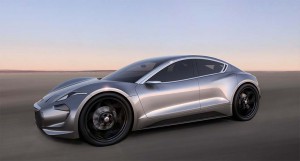
Henrik Fisker said last fall he'd be back with a new EV and now the first glimpses at it are available.
There were plenty of skeptics when long-time designer and entrepreneur Henrik Fisker announced late last year that he was getting back into the automotive game with an all-new electric sports car dubbed EMotion.
It didn’t help that his prior project, the eponymous Fisker Automotive, crashed and burned in spectacular fashion. But with a first public unveiling set for August, Fisker is shoring up his promised comeback by offering the first teaser images of the EMotion, while also offering up more information about both the unusual drivetrain and the semi-autonomous technologies it will feature.
“The new EMotion is a clean sheet design from the inside out, utilizing a carbon fiber and aluminum structure to redefine the proportions of an electric vehicle,” Fisker Inc. said in a statement accompanied by three teaser shots.
Most of today’s electric vehicles are designed like conventional vehicles. That has meant they often sacrifice passenger and cargo space to make room for their batteries. Tesla – and more recently, Chevrolet – have adopted a new layout in which the batteries are mounted within the vehicle floor, opening up more interior space. Fisker claims he is going still further, taking back space normally devoted to a gas-powered drivetrain to deliver an exceptionally roomy cabin.
(Henrik Fisker wants back in. Click Here for word on the new car company he hopes to launch.)

Fisker's new EMotion will get a full unveiling in August, but the company says it has a range of 400 miles.
From what the teaser images reveal, the new sports car was designed with extreme aerodynamics in mind, with a low, wind-cheating hood, extremely raked windshield and sleek roof line. The windows are framed in “double-polished” aluminum moldings. The front and rear lamps are slit-like designed, and the back of the car features an integrated carbon-fiber diffuser.
Instead of conventional sideview mirrors, the EMotion will use two videocameras and provide “panoramic, 360-degree views to the driver.” Lots of companies have wanted to offer that technology – especially since pencil-thin cameras would reduce aero drag and wind noise. The question is how Fisker would pull that off, as that technology is not yet approved by U.S. automotive regulators.
As for the battery, well, there seems to be some mystery left as to exactly how the Fisker EMotion will be powered. When he first resurfaced late last year, the Danish designer said he was adopting a unique energy storage system, an advanced version of supercapacitor technology.

The design of the EMotion provides for an exceptionally roomy and comfortable cabin, the company notes.
Supercapacitors can charge or discharge at extremely high speeds, but they have, at least until now, been able to store only a very small amount of power. Working with researchers at UCLA who developed a Nobel Prize winning material called graphene, Fisker initially claimed his supercapacitors can hold more energy than a battery.
(Click Here for an initial review of the new Karma Revero.)
But, in a subsequent conversation with TheDetroitBureau.com he blurred details and it is now a bit unclear whether EMotion will rely solely on supercapacitors or a combination of those devices and more familiar lithium-ion batteries.
Whatever the combination, Fisker would clearly have a stand-out zero-emissions vehicle on its hands if it meets its promised target of 400 miles ranger per charge.
Another interesting technology promised by Fisker is a LIDAR, or 3D laser camera system, tucked into the EMotion’s nose. LIDAR is considered essential to autonomous driving, but it is expensive and still experimental. It is unclear what Fisker might be planning in terms of hands-free capabilities at this point.
As to how you might order one, Fisker Inc. is going after a non-traditional distribution system – no surprise since rival Tesla Motors has taken a similar approach with its factory-owned dealer network. It’s not even clear there will be conventional dealerships, Fisker’s promising to set up “experience centers” and take orders directly through its website. That could prove tricky, however, as most states have strict franchise laws in place – something that has limited the number of outlets Tesla has been able to set up.
As for service, Fisker is partnering with The Hybrid Shop to handle customer needs. It is promising “a seamless day ‘free of interruption’ for routine maintenance and servicing,” which suggests it will likely offer valet pickup and returns and loaners while an owner’s vehicle is in the shop.
(To see more about Tesla’s newest introduction, the Model 3, Click Here.)
Look for a price of $129,900, including the 400-mile battery pack, Fisker Inc. says.


First and Second pictures have snake elements, with the second picture showing Hyundai Genesis Coupe grille-area.
Third pic has a sexy quarter-panel sweep and ducktail.
The fourth picture is a failure to me, the overall shape being derivative and unfortunately predictable. A let down.